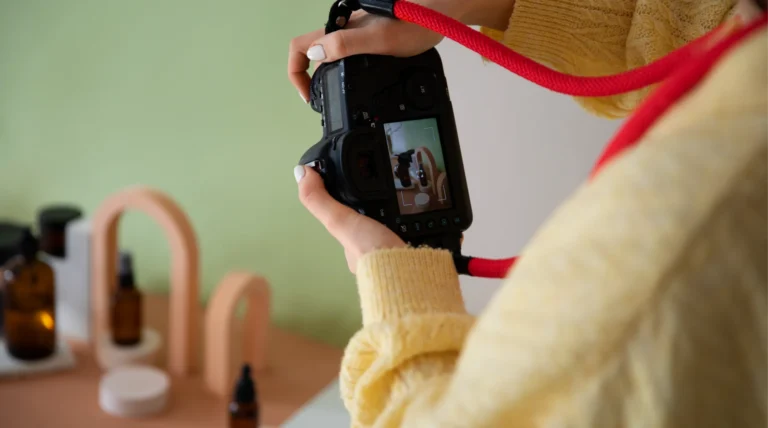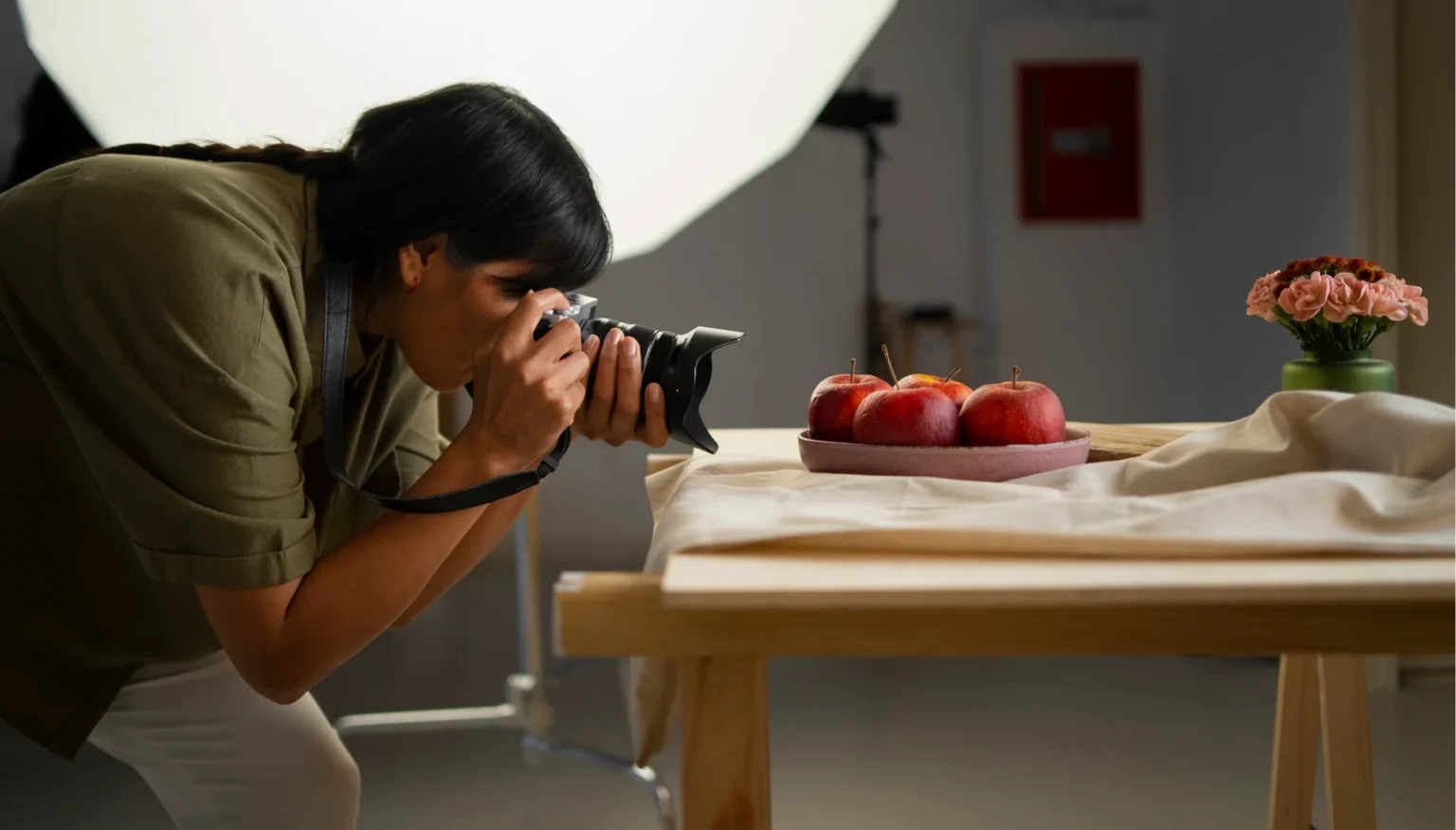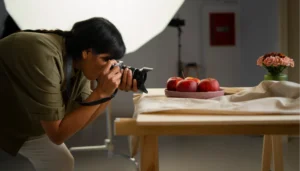In the dynamic world of e-commerce and visual storytelling, editorial product photography emerges as a powerful tool, transcending the boundaries of standard product images. This specialized form of visual communication goes beyond mere representation, transforming products into protagonists within a carefully curated narrative.
Let’s delve into the intricacies of editorial product photography, exploring its nuances, various types, and its pivotal role in building brand identity and connecting with the audience on a deeper, emotional level.
Defining editorial product photography

Editorial product photography is an art form that transcends the traditional boundaries of commercial product images. While standard product photography straightforwardly focuses on showcasing products, editorial product photography weaves a compelling story around the product.
It aims to evoke emotions, trigger imagination, and create a unique brand narrative. Editorial product photography diverges from standard product images through contextual storytelling, placing the product within a narrative framework that breathes life into its essence.
Unlike standard images that prioritize clarity against neutral backgrounds, editorial photography leverages diverse settings, lighting, and props to evoke specific moods, adding depth and character to the product. The dynamic compositions and angles used in editorial product photography treat the product as a central character within a larger visual narrative.
They incorporate storytelling elements that connect the product with lifestyle and culture, presenting it as an integral part of a broader story. This approach fundamentally alters the viewer’s engagement, transforming a product from a simple commodity to a protagonist in a captivating narrative.
Distinguishing features - redefining visual narratives

In the dynamic landscape of visual communication, editorial product photography stands as a beacon of innovation, redefining how products are portrayed compared to conventional standard product images. This approach creates a realm of storytelling and immersive brand experiences.
Contextual storytelling
While standard product images traditionally focus on showcasing the product in isolation, accentuating its features, editorial photography takes a bold step forward.
It places the product within a carefully crafted context, constructing a visual narrative that resonates with the brand’s ethos. This form of storytelling invites consumers to connect with the product on a deeper level, envisioning its role in their daily lives.
Atmosphere and mood
Departing from the neutrality often found in standard images, editorial ones introduce a new dimension by deliberately crafting atmosphere and mood.
Through diverse settings, nuanced lighting, and strategic props, it evokes emotions within the audience. This intentional approach adds depth and character to the product, establishing an emotional connection with the audience.
Dynamic composition
In the realm of composition, standard pictures tend to prioritize clear visibility. Conversely, editorial images embrace dynamism.
This technique explores inventive compositions, incorporates unique angles, and employs diverse perspectives. By treating the product as an integral element within a broader visual narrative, editorial product photography creates an engaging and visually compelling experience for viewers.
Narrative elements
Standard product images tend to limit the product, as they present the physical attributes. Editorial images, however, break free from these limitations, introducing narrative elements into the visual representation.
This includes connecting the product with broader themes such as lifestyle, culture, or the overarching narrative of the brand. The infusion of storytelling transforms the product into a character within a richer, more resonant story.
Color palette and styling
Editorial product photography often explores a broader spectrum of color palettes and styling choices compared to the restrained and standardized approach. This allows for creative expression and brand differentiation, as the color and style are integral components of the overall narrative.
Composition of negative space
Another distinguishing element lies in the intentional use of negative space. The standard images may fill the frame with the product, but editorial photography strategically incorporates negative space to guide the focus, emphasize key elements, and contribute to the overall aesthetic appeal.
In summary, the distinguishing features of editorial product photography extend beyond the boundaries of standard product images. Through contextual storytelling, intentional atmosphere creation, dynamic compositions, narrative elements, a diverse color palette, and thoughtful use of negative space, editorial product photography emerges as a transformative force in conveying brand narratives with depth and creativity.
Various types of editorial photography

Editorial product photography is a realm where creativity intertwines with commerce, transcending the boundaries of conventional visual representation. Within this dynamic field, various types of editorial product photography emerge, each contributing to a rich tapestry of visual storytelling.
Lifestyle: This places products within real-life scenarios, showcasing how they seamlessly integrate into the consumer’s daily life. It connects the product with the audience on a personal and relatable level, fostering a sense of authenticity.
Conceptual:
It delves into abstract ideas or themes associated with the product. This approach sparks imagination and triggers emotions, creating a narrative that goes beyond the physical attributes of the product.
Editorial Fashion Photography:
Editorial fashion photography blends the world of fashion with product representation, creating visually stunning narratives around clothing, accessories, or beauty products. This type of photography often emphasizes trends, style, and the overall aesthetic appeal of the products.
Seasonal:
Seasonal editorial photography tailors visual narratives to align with specific seasons, holidays, or events. So, it connects the product with timely and relevant themes, allowing brands to stay dynamic and engaging throughout the year.
Dynamic composition and narrative elements:
In addition to the mentioned types, dynamic composition and the incorporation of narrative elements stand out as distinguishing features of editorial product photography. Unlike standard product images, editorial photography embraces diverse settings, lighting, and props, treating the product as part of a larger visual narrative.
These diverse types of editorial product photography collectively contribute to a brand’s ability to communicate a nuanced, multi-faceted narrative. They help brands create a visual identity that resonates deeply with their target audience.
Crafting brand narratives

Beyond the visual allure, editorial product photography plays a pivotal role in shaping brand narratives and connecting with consumers on a profound level. Its ability to go beyond mere representation opens roads for crafting a brand identity that goes straight to the heart of your audience.
Editorial product photography serves as a powerful tool for establishing brand identity. It allows your brand to express its personality, values, and mission visually, creating a distinctive and memorable presence in the market.
Beyond the tangible aspects of a product, this type of product photography fosters emotional connections with consumers. By placing products within relatable contexts and weaving stories, brands can resonate with their audience on a personal and emotional level.
The impact extends beyond aesthetics, becoming a valuable asset for marketing campaigns and branding efforts. These images elevate the overall visual appeal of a brand, contributing to a cohesive and compelling marketing strategy.
Editorial product photography allows you to craft narratives that are not only timeless but also timely. By aligning with current trends, events, or cultural moments, brands can stay relevant and maintain a dynamic presence in the ever-evolving consumer landscape.
Another role is its ability to infuse creativity into visual communication. It opens the door to innovative compositions, artistic expressions, and visually striking representations that set a brand apart.
To sum up, in the intricate dance between commerce and creativity, editorial product photography helps shape brand narratives, connecting them emotionally with their audience while enhancing the overall visual language of a brand.
Integration with CGI

The integration of editorial product photography with CGI has become a prevailing trend, expanding the horizons of visual storytelling.
CGI brings limitless creative possibilities, allowing for the creation of fantastical scenes, surreal environments, and visually striking compositions that transcend the constraints of traditional photography. Take a look at our portfolio to get an idea of how computer-generated imagery can elevate your brand.
This seamless integration enhances the storytelling potential, offering brands a broader canvas to communicate their message and captivate their audience.
In this synergy, traditional photography blends seamlessly with CGI, resulting in visuals that are not only aesthetically pleasing but also conceptually rich.
By combining the tangible aspects of products captured through photography with the boundless creativity of CGI, brands can elevate their storytelling and create immersive experiences for their audience. Take advantage of our free trial and go digital to raise your brand’s potential.
Wrapping up
In conclusion, editorial product photography emerges as a compelling storyteller, weaving narratives around products and brands. Its ability to connect with the audience emotionally, establish brand identity, and seamlessly integrate with CGI positions it as an indispensable tool in the visual communication arsenal.
FAQ
How does editorial product photography contribute to brand storytelling?
Editorial product photography goes beyond showcasing products; it builds narratives that connect with consumers. By placing products in real-life scenarios or conceptual settings, brands can convey a lifestyle and values, fostering a deeper connection with the audience.
Can editorial product photography be used for all types of products?
Yes, editorial product photography is versatile and can be adapted for various products. From fashion and beauty items to electronics and lifestyle goods, this approach adds a unique touch to the visual representation of any product.
What role does lighting play in editorial product photography?
Lighting is crucial in setting the mood and atmosphere of the visual narrative. Well-crafted lighting enhances the product’s features and contributes to the overall aesthetic appeal, creating a captivating image.
How does editorial product photography impact consumer perception?
Editorial product photography shapes consumer perception by providing a holistic view of the product within a broader context. It allows consumers to envision how the product fits into their lives, influencing their purchasing decisions.
Can CGI be seamlessly integrated into editorial product photography?
Absolutely. CGI offers endless possibilities for creating fantastical or hyper-realistic settings. When integrated thoughtfully, it enhances the storytelling aspect of editorial product photography, providing a unique visual experience.



